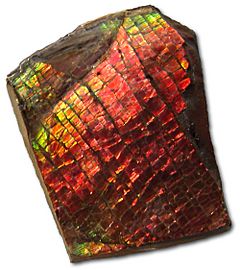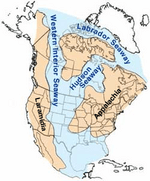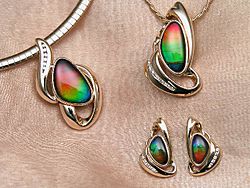Ammolite facts for kids
Quick facts for kids Ammolite |
|
|---|---|

Unprocessed sample of ammolite; a "dragon skin" pattern is apparent
|
|
| General | |
| Category | fossilized, mineralized Ammonite shell |
| Formula (repeating unit) |
CaCO3 aragonite polymorph, with minor amounts of calcite, pyrite, silica, and other impurities |
| Identification | |
| Color | Gray to brown, can be radiant blue, with primarily red to green iridescence. |
| Cleavage | no true cleavage |
| Fracture | uneven to granular |
| Mohs scale hardness | 3.5 - 4.5 |
| Luster | greasy to dull |
| Specific gravity | usually about 2.70 (varies with mineral content) |
| Polish luster | vitreous |
| Optical properties | anomalous aggregate reaction |
| Refractive index | usually 1.52 - 1.68 (varies with mineral content) |
| Birefringence | 0.135 - 0.145 |
| Pleochroism | none |
| Ultraviolet fluorescence | variable |
Ammolite is a special, colorful gemstone that looks a lot like opal. You can find it mostly in the Rocky Mountains of North America. This unique gem is actually made from the fossilized shells of ancient sea creatures called ammonites.
Ammonite shells are mostly made of a mineral called aragonite. This is the same mineral found in nacre, which is what makes pearls shiny. Ammolite is one of the few gemstones that come from living things. Other examples include amber and pearls.
In 1981, ammolite was officially recognized as a gemstone. This was done by the World Jewellery Confederation (CIBJO). That same year, people started mining ammolite to sell it. In 2007, it became the official gemstone of Lethbridge, a city in Alberta, Canada.
Ammolite has a few other names, like aapoak, which means "small, crawling stone" in the Kainah language. It's also known as calcentine and Korite. Korite is a brand name given by a mining company in Alberta called Korite.
Contents
What Makes Ammolite Special?
Ammolite's amazing colors come from its unique structure. It's mostly made of aragonite, but it can also have other minerals like calcite and pyrite. The shell itself might contain tiny amounts of other elements, like iron and magnesium. Ammolite is not very hard, scoring between 3.5 and 4.5 on the Mohs scale of mineral hardness. This means it can be scratched more easily than harder gems like diamonds.
How Ammolite Gets Its Colors
The most striking thing about ammolite is its iridescence. This means it shows a rainbow of colors, like an opal. You'll mostly see shades of green and red, but all spectral colors are possible.
The colors aren't from light being absorbed, like in most gems. Instead, they come from how light bounces off tiny, stacked layers of aragonite in the shell. This is called light interference.
- If the layers are thicker, you'll see more reds and greens.
- If the layers are thinner, you'll see more blues and violets.
Reds and greens are more common because the thinner layers that make blues are more fragile. When ammolite is first dug up, its colors aren't very bright. It needs to be polished to show its full beauty.
A Thin and Fragile Gem
Ammolite itself is very thin, usually less than a millimeter thick. It's almost always found attached to its original rock, called the matrix. This matrix is usually a gray or brown rock like shale or limestone.
Because it's so thin, ammolite can easily crack and flake. This often happens when it's exposed to weather or squeezed by other rocks. This cracking creates a pattern that looks like "dragon skin" or a "stained glass window." Ammolite found deeper underground might be smoother.
Sometimes, a whole ammonite shell is found with its colorful ammolite layer still on it. These shells can be quite large, but the iridescent ones are usually smaller. Most fossilized shells have changed over time, so finding ammolite is quite rare!
Where Ammolite Comes From
Ammolite comes from the fossil shells of specific types of ammonites. These were sea creatures similar to squid or octopuses, but they lived inside coiled shells. They thrived in warm, tropical seas a very long time ago, during the Cretaceous period. They died out around the same time as the dinosaurs.
The ammonites that became ammolite lived in a huge inland sea that covered parts of North America. This sea was next to the Rocky Mountains. When these ammonites died, they sank to the bottom. They were then covered by layers of soft mud that later turned into shale. These sediments protected the aragonite in their shells, stopping it from changing into other minerals.
Where to Find Ammolite
Large amounts of good quality ammolite have only been found in the Bearpaw Formation. This rock layer stretches from Alberta and Saskatchewan in Canada down to Montana in the USA. The best ammolite is found along rivers on the eastern side of the Rockies in southern Alberta.
Most of the mining happens along the St. Mary River, near the towns of Magrath and Lethbridge. About half of all ammolite is found on the Kainah (Blood) reserve. The Kainah people play a big part in ammolite mining. The company Korite has worked closely with the Kainah tribe since 1979. There are also many self-employed Kainah miners who dig for ammolite.
How Ammolite Is Mined
Mining ammolite is done using machines, but it's quite simple. Workers dig shallow open pits with a backhoe. Then, they sort through the dug-up material to find the gems. People also search by hand and sell what they find to companies like Korite. About half of the ammolite found is good enough for jewelry. Korite is the biggest miner, producing over 90% of the world's ammolite.
Ammolite is found in different layers underground:
- The top layer, called the "K Zone," is about 15 meters (50 feet) deep. The ammolite here is often cracked. This is the most common type and usually less valuable.
- Deeper down, about 20 meters (65 feet) below the "K Zone," is the "Blue Zone." Ammolite from this layer is usually less cracked and more valuable. It's also harder to reach.
As of 2015, Korite had mined over 100 acres of ammolite. The company employs many people and produces most of the world's supply.
Ammolite Quality
Ammolite is graded using a letter system to show its quality: AA, A+, A, and A−. AA is the best. However, this system isn't always the same, so some sellers might use their own. The value of an ammolite gem depends on several things:
- Brightness of Color: How vivid and intense the colors are.
- Number of Colors: Gems with more colors are usually more valuable.
- How Colors Change: If the colors change when you turn the gem, it's more desirable.
- Pattern: Unique patterns, like the "dragon skin," can add value.
- Thickness: Thicker ammolite layers are more valuable.
After polishing, ammolite is usually only 0.1–0.3 millimeters thick. The rarest and most valuable pieces are thick enough to be used on their own. But most ammolite needs a dark backing to support it. The less treatment an ammolite gem has, the more valuable it is.
How Ammolite Is Treated
Ammolite is quite delicate, so it's often treated to make it stronger. The thin layers can easily flake. To prevent this, most ammolite is soaked in a clear epoxy or other special resin. This helps stabilize the gem before it's cut. This treatment makes ammolite much more durable and available for jewelry.
Because the ammolite layer is so thin, most ammolite gems are actually composite stones. This means they are made of several parts:
- Doublets: These have the thin ammolite layer glued onto a dark backing material. This backing is often the original rock, but it can also be black onyx or glass.
- Triplets: If the ammolite layer is extremely thin, a third clear, domed layer is added on top. This top layer can be made of synthetic spinel, quartz, or glass. This clear cap acts like a lens, making the ammolite's colors look even brighter.
You can often tell if a stone is a doublet or triplet by looking at it closely with a loupe (a small magnifying glass). If it's a triplet, you'll see the clear domed top layer. If the top is glass, you might even see tiny bubbles or scratches.
Most ammolite sold today has been treated in some way. Sellers should always tell you if a gem has been treated.
Similar-Looking Gems
Ammolite isn't often copied, but a few other materials might look similar to someone who doesn't know much about gems. These include:
- Labradorite: This is another iridescent mineral, sometimes called spectrolite. It can also be found in Canada. It has flashes of color, but it doesn't look exactly like ammolite.
- Black opal: This gem also has a play of color, but it's usually more valuable than ammolite. In fact, ammolite is sometimes used to imitate black opal.
- Slocum stone: This is a common glass-based imitation of opal.
In labradorite and opal, the colors seem to roll across the stone. In ammolite, the colors are more fixed in patches. Also, ammolite is completely opaque, meaning you can't see through it. The imitations might be transparent or translucent from some angles.
Another material that can look a bit like ammolite is the shell of abalone (also known as paua). Abalone shells are cheap and plentiful. They have wavy bands of blue, green, and pink colors. Abalone shell has a silky shine, not the glassy shine of polished ammolite. However, some abalone shells are dyed and given a clear top layer to make them look like ammolite or opal.
Ammolite in Jewelry
Ammolite hasn't been used in jewelry for a very long time. It only started becoming popular in the Western world in the 1970s.
The Blackfeet tribe, a Native American group, have known about ammolite for much longer. They call it iniskim, which means "buffalo stone." They believed it had special powers, like helping them find buffalo for hunting. The Blackfeet also thought ammolite had healing powers and used it in their special ceremonies.
In the late 1990s, people who practice feng shui started promoting ammolite. They believe it's an "influential" stone that can improve well-being and energy flow. They call it the "Seven Color Prosperity Stone." Each color is thought to bring different positive effects. A mix of red, green, and yellow is especially popular, as these colors are believed to bring growth, wisdom, and wealth.
Ammolite is usually cut into smooth, rounded shapes called cabochons. It's often set in gold and sometimes has diamonds as accents. Because ammolite is delicate, it's best used in pendants, earrings, and brooches. If it's used in a ring, it should have a hard, clear protective cap, like the one used in triplets.
To clean ammolite jewelry, only use mild soap and warm water. Never use ultrasonic cleaners, as they can damage the gem.
Japan is the biggest market for ammolite. This might be because it's used to imitate black opal, which is becoming harder to find. It's also popular there due to its use in feng shui. Other places where ammolite is popular include Canada, where artists and jewelers sell it to tourists visiting places like Banff National Park. It's also used by Zuni and other Native American craftspeople in the Southwestern United States.
|
See also
 In Spanish: Ammolita para niños
In Spanish: Ammolita para niños








